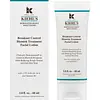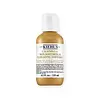Kiehl's Breakout Control Blemish Treatment Facial Lotion Versus Kiehl's Calendula Skin-Soothing & Stabilizing Emulsion
What's inside
What's inside
 Key Ingredients
Key Ingredients

 Benefits
Benefits

 Concerns
Concerns

 Ingredients Side-by-side
Ingredients Side-by-side

Water
Skin ConditioningAloe Barbadensis Leaf Juice
Skin ConditioningDi-C12-13 Alkyl Malate
EmollientNiacinamide
SmoothingCyclohexasiloxane
EmollientPropylene Glycol
HumectantAluminum Starch Octenylsuccinate
AbsorbentPEG-100 Stearate
Glyceryl Stearate
EmollientSalicylic Acid
MaskingCetyl Alcohol
EmollientAcrylates/C10-30 Alkyl Acrylate Crosspolymer
Emulsion StabilisingSodium Hydroxide
BufferingCapryloyl Salicylic Acid
ExfoliatingXanthan Gum
EmulsifyingZinc PCA
HumectantZingiber Officinale Root Extract
MaskingStearyl Alcohol
EmollientMyristyl Alcohol
EmollientOctadecenedioic Acid
EmulsifyingCitral
PerfumingBHT
AntioxidantWater, Aloe Barbadensis Leaf Juice, Di-C12-13 Alkyl Malate, Niacinamide, Cyclohexasiloxane, Propylene Glycol, Aluminum Starch Octenylsuccinate, PEG-100 Stearate, Glyceryl Stearate, Salicylic Acid, Cetyl Alcohol, Acrylates/C10-30 Alkyl Acrylate Crosspolymer, Sodium Hydroxide, Capryloyl Salicylic Acid, Xanthan Gum, Zinc PCA, Zingiber Officinale Root Extract, Stearyl Alcohol, Myristyl Alcohol, Octadecenedioic Acid, Citral, BHT
Water
Skin ConditioningGlycerin
HumectantIsopropyl Lauroyl Sarcosinate
Skin ConditioningDimethicone
EmollientNiacinamide
SmoothingPropanediol
SolventPropylene Glycol
HumectantC14-22 Alcohols
Emulsion StabilisingPanthenol
Skin ConditioningDimethicone/Vinyl Dimethicone Crosspolymer
Skin ConditioningPhenoxyethanol
PreservativeTocopherol
AntioxidantCapryloyl Salicylic Acid
ExfoliatingC12-20 Alkyl Glucoside
EmulsifyingCarbomer
Emulsion StabilisingPyridoxine Hcl
Skin ConditioningChlorphenesin
AntimicrobialPentaerythrityl Tetra-Di-T-Butyl Hydroxyhydrocinnamate
AntioxidantXanthan Gum
EmulsifyingAcrylates/C10-30 Alkyl Acrylate Crosspolymer
Emulsion StabilisingCitrus Limon Peel Oil
MaskingLimonene
PerfumingCalendula Officinalis Flower
Skin ConditioningTrisodium Ethylenediamine Disuccinate
Zinc PCA
HumectantMaltodextrin
AbsorbentSodium Hydroxide
BufferingCalendula Officinalis Flower Extract
MaskingGeranium Maculatum Oil
MaskingChamomilla Recutita Flower Oil
MaskingCitric Acid
BufferingCitral
PerfumingCamellia Sinensis Leaf Extract
AntimicrobialCitronellol
PerfumingGeraniol
PerfumingLinalool
PerfumingCymbopogon Schoenanthus Oil
MaskingArtemisia Absinthium Extract
Skin ConditioningWater, Glycerin, Isopropyl Lauroyl Sarcosinate, Dimethicone, Niacinamide, Propanediol, Propylene Glycol, C14-22 Alcohols, Panthenol, Dimethicone/Vinyl Dimethicone Crosspolymer, Phenoxyethanol, Tocopherol, Capryloyl Salicylic Acid, C12-20 Alkyl Glucoside, Carbomer, Pyridoxine Hcl, Chlorphenesin, Pentaerythrityl Tetra-Di-T-Butyl Hydroxyhydrocinnamate, Xanthan Gum, Acrylates/C10-30 Alkyl Acrylate Crosspolymer, Citrus Limon Peel Oil, Limonene, Calendula Officinalis Flower, Trisodium Ethylenediamine Disuccinate, Zinc PCA, Maltodextrin, Sodium Hydroxide, Calendula Officinalis Flower Extract, Geranium Maculatum Oil, Chamomilla Recutita Flower Oil, Citric Acid, Citral, Camellia Sinensis Leaf Extract, Citronellol, Geraniol, Linalool, Cymbopogon Schoenanthus Oil, Artemisia Absinthium Extract
 Reviews
Reviews

Ingredients Explained
These ingredients are found in both products.
Ingredients higher up in an ingredient list are typically present in a larger amount.
Acrylates/C10-30 Alkyl Acrylate Crosspolymer is a synthetic polymer. It is used to thicken and improve the texture of products. Due to its properties, it can prevent water and oil ingredients from separating.
Capryloyl Salicylic Acid comes from salicylic acid, the famous acne-fighting BHA.
It usually goes by a more common name of LHA, or lipohydroxy acid.
Like salicylic acid, this ingredient is a chemical exfoliant that can help break down the oil in your pores and reduce inflammation.
Though studies for LHA do show it to be less effective than salicylic acid. To be fair, salicylic acid is the reigning monarch of acne treatments.
However, a study from 2009 found LHA to be comparable to BPO, making it a good alternative for people with sensitive skin. Another study of 14 patients found a significant decrease in comedones after using LHA.
Another pro of LHA? It is less irritating than salicylic acid due to its large molecule size.
Large molecules cannot penetrate skin as well, so they are gentler on the skin. LHA is much less penetrative than salicylic acid.
An in-vitro study (not done on a living organism) found only 6% of LHA penetrated past the statum corneum compared to 58% of salicylic acid. An in-vivo (done on a living organism) analysis revealed ~17% of LHA was still present in the top layer of skin after 4 days, versus ~9% of salicylic acid.
Interestingly, a study from 2008 found LHA comparable to another famous acid, glycolic acid.
This study found about 10% of LHA is as effective as 20-50% of glycolic acid in treating hyperpigmentation and fine-lines.
Hydroxy acids have been found to stimulate skin protein, lipids, and thermal thickening. This may have anti-aging benefits.
Learn more about Capryloyl Salicylic AcidCitral is a fragrance and used to add a lemon-like scent to products. It is both naturally found in plants and created synthetically. In plants, it is commonly occurring in lemon myrtle, lemongrass, lemon tea-tree, lemon verbena, and other citruses.
The EU mandates Citral be listed separately as a fragrance. It is a known allergen and may cause contact dermatitis. Citral can also used as a masking ingredient.
The term 'fragrance' is not regulated in many countries. In many cases, it is up to the brand to define this term. For instance, many brands choose to label themselves as "fragrance-free" because they are not using synthetic fragrances. However, their products may still contain ingredients such as essential oils that are considered a fragrance.
The term 'citral' is a collective term for two geometric isomers: geranial/Citral A and neral/Citral B.
Learn more about CitralNiacinamide is a multitasking form of vitamin B3 that strengthens the skin barrier, reduces pores and dark spots, regulates oil, and improves signs of aging.
And the best part? It's gentle and well-tolerated by most skin types, including sensitive and reactive skin.
You might have heard of "niacin flush", or the reddening of skin that causes itchiness. Niacinamide has not been found to cause this.
In very rare cases, some individuals may not be able to tolerate niacinamide at all or experience an allergic reaction to it.
If you are experiencing flaking, irritation, and dryness with this ingredient, be sure to double check all your products as this ingredient can be found in all categories of skincare.
When incorporating niacinamide into your routine, look out for concentration amounts. Typically, 5% niacinamide provides benefits such as fading dark spots. However, if you have sensitive skin, it is better to begin with a smaller concentration.
When you apply niacinamide to your skin, your body converts it into nicotinamide adenine dinucleotide (NAD). NAD is an essential coenzyme that is already found in your cells as "fuel" and powers countless biological processes.
In your skin, NAD helps repair cell damage, produce new healthy cells, support collagen production, strengthen the skin barrier, and fight environmental stressors (like UV and pollution).
Our natural NAD levels start to decline with age, leading to slower skin repair, visible aging, and a weaker skin barrier. By providing your skin niacinamide, you're recharging your skin's NAD levels. This leads to stronger, healthier, and younger looking skin.
Another name for vitamin B3 is nicotinamide. This vitamin is water-soluble and our bodies don't store it. We obtain Vitamin B3 from either food or skincare. Meat, fish, wheat, yeast, and leafy greens contain vitamin B3.
The type of niacinamide used in skincare is synthetically created.
Learn more about NiacinamidePropylene Glycol is an odorless, colorless liquid. As a humectant, it helps skin retain moisture. It also aids in delivering active ingredients.
Another role of this ingredient is preventing a product from melting or freezing. Propylene glycol also adds antimicrobrial properties to a product, elongating product lifespan.
This ingredient is considered an organic alcohol and commonly added into both cosmetics and foods.
Those with sensitive skin or conditions may develop a rash when using this ingredient.
Learn more about Propylene GlycolSodium Hydroxide is also known as lye or caustic soda. It is used to adjust the pH of products; many ingredients require a specific pH to be effective.
In small amounts, sodium hydroxide is considered safe to use. However, large amounts may cause chemical burns due to its high alkaline.
Your skin has a natural pH and acid mantle. This acid mantle helps prevent harmful bacteria from breaking through. The acid mantle also helps keep your skin hydrated.
"Alkaline" refers to a high pH level. A low pH level would be considered acidic.
Learn more about Sodium HydroxideWater. It's the most common cosmetic ingredient of all. You'll usually see it at the top of ingredient lists, meaning that it makes up the largest part of the product.
So why is it so popular? Water most often acts as a solvent - this means that it helps dissolve other ingredients into the formulation.
You'll also recognize water as that liquid we all need to stay alive. If you see this, drink a glass of water. Stay hydrated!
Learn more about WaterXanthan gum is used as a stabilizer and thickener within cosmetic products. It helps give products a sticky, thick feeling - preventing them from being too runny.
On the technical side of things, xanthan gum is a polysaccharide - a combination consisting of multiple sugar molecules bonded together.
Xanthan gum is a pretty common and great ingredient. It is a natural, non-toxic, non-irritating ingredient that is also commonly used in food products.
Learn more about Xanthan GumZinc PCA (or "zinc salt") differs slightly from zinc itself. PCA stands for pyrrolidone carboxylic acid. However, Zinc PCA comes from zinc.
It can help reduce redness, regulate sebum, and promote the general healing process of the skin.
Zinc PCA tends to be especially useful for those with oily, acne-prone skin. It's certainly an ingredient worth trying out!
Learn more about Zinc PCA